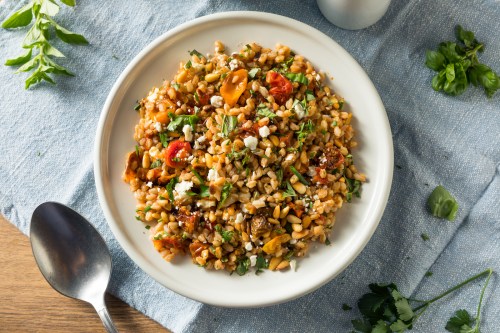Our editors independently select these products. Making a purchase through our links may earn Well+Good a commission
The ‘Big 4’ Health Benefits of Farro That Make This Ancient Grain a Modern Favorite for Dietitians
Discover the major health benefits of farro, which can impact your immune system, gut, heart, and metabolism.

As ancient grains continue to gain popularity amongst foodies and the health-conscious alike, farro is finally getting the modern spotlight it deserves. Farro is a type of wheat with deep historical roots, and it’s making a splash in Western food culture as a delicious and nutritious whole-grain option. But many may not realize that farro goes by several different names which can make navigating a purchase tricky and intimidating. So, read on to learn all about what farro is, the different varieties available, how it benefits our health, and ways to use it at home!
Experts in This Article
registered dietitian
What is farro?
As a type of wild wheat, farro (scientific name: Triticum dicoccum) dates back to at least 10,000 years ago when it originated in the Fertile Crescent in Mesopotamia alongside many other ancient grains. This land encompasses parts of modern-day Iran, Iraq, Israel, Jordan, Palestine, Syria, and Turkey. And after all of these years, farro remains a culturally significant culinary staple in this area of the world.
As it often refers to three types of ancient wheat that it’s very closely related to, farro goes by many names: einkorn, emmer, and spelt. To complicate things even further, you may also see it for purchase under the names of farro piccolo for einkorn, farro medio for emmer, and farro grande for spelt. Despite the sheer number of names this grain can go by, if you have any of these products in your cart, you can rest assured that you’re buying farro (or a very close relative).
This grain looks similar to wheat berries before cooking and barley after. It has a light brown color and, once cooked, offers a soft, chewy texture. This nicely accompanies its mild, slightly nutty flavor to make it the perfect addition to a variety of dishes.
Farro will always be sold hulled, as that part of the grain is inedible, but is also available in semi-pearled and pearled varieties. Hulled farro is the whole grain option as its bran is still intact, preserving its full fiber and nutritive value. Meanwhile, semi-pearled will have some of the bran removed, and pearled will have all of it removed. This means that semi-pearled farro will have less nutrition than hulled farro but more than pearled farro. (Clear as mud, right?) However, there’s a culinary tradeoff here as semi-pearled and pearled farro will cook up in a much shorter time. Whole grain, hulled farro typically requires an overnight soak before cooking.
While farro can be found in some grocery and health food stores, it is widely available online for purchase. However, as this historical grain grows in popularity, so does its availability in markets across the country, so it may be popping up at your local market sooner than you think.
Health benefits of farro
Though the flavor of farro is undoubtedly delicious, its nutrition profile is really what has people talking. This is thanks to the protein, fiber, zinc, selenium, iron, magnesium, niacin, and plant compounds it offers that translate into some impressive health benefits.
Improves immune health
In farro, you’ll find impressive amounts of a variety of plant compounds including lutein1, polyphenols, carotenoids, and phytoesters. These bioactive compounds in combination with zinc and selenium act as antioxidants2 in the body which help to reduce inflammation and fight off disease-causing free radical molecules.
In particular, lutein is associated with better eye health3 while overall increased whole grain consumption4, including farro, is linked to reduced risk for cancer and all-cause mortality. Plus, two of the types of fiber found in this re-emerging grain, resistant starch and soluble fiber, are prebiotics that feed the healthy bacteria in your gut microbiome, which is intricately linked to our overall immune health. Resistant starch intake is even associated with reduced colon cancer risk.
Boosts gut health
Speaking of fiber, this macronutrient found in farro also helps to support our overall gut and digestive health. As a source of insoluble fiber, soluble fiber, and resistant starch, this ancient grain addresses gut health from multiple angles. The insoluble fiber it contains acts as a bulking agent in the gastrointestinal (GI) tract, helping to maintain digestive regularity and address common concerns like constipation. Meanwhile, soluble fiber forms a gel in the GI tract offering relief for the opposite problem, diarrhea. Again, both soluble fiber and resistant starch are prebiotic foods that will help to maintain overall digestive health by supporting a thriving microbiome, the diverse community of microorganisms residing in the gastrointestinal tract, playing a crucial role in digestion, immune function, and overall health.
Betters heart health
Soluble fiber is also partially to thank for the heart health benefits farro offers. Soluble fiber binds to dietary cholesterol in the small intestine helping to rid it from the body instead of allowing it to enter the bloodstream where it can lead to plaque build-up in the veins or arteries. This build-up is called atherosclerosis and is a tell-tale symptom of heart disease.
Meanwhile, the magnesium in this grain supports heart health as a major electrolyte, vital for healthy heart rhythms, and the B vitamin niacin in farro may also help to regulate blood cholesterol levels, further championing heart health.
Supports metabolic health
Our metabolic health is also supported by farro, thanks to the fiber and protein it contains. Both fiber and protein slow digestion and, in turn, dull the blood sugar response. This means that after eating whole-grain farro, our blood sugar levels will rise and drop more slowly during the digestive process. This bodes well for people with metabolic concerns like diabetes but also for those without them as this blood sugar response results in more stable, sustained energy levels in general. Evidence5 also tells us that regular whole grain consumption, including farro, reduces the overall risk for metabolic concerns like type 2 diabetes.
Enjoying farro at home
So with all these appealing benefits, you may be wondering how you should go about using farro at home? Well, we’ve got lots of ideas.
Once you buy your dried farro at the supermarket or online and soak it overnight (if it’s whole grain hulled farro), you’re ready to cook. After soaking, farro cooks up very similarly to other whole grains including quinoa, rice, barley, buckwheat, and even oats. In turn, it serves as the perfect alternative for any use you’d have for these grains. This means that it can be an excellent addition to soups, salads, stews, stuffed peppers, or casseroles as well as a fantastic base for stir fries, curries, grain bowls, and risottos.
Farro can also be eaten as a porridge in place of oats or be made into a granola or muesli to top yogurt, chia pudding, or pancakes in the morning. Plus, farro flour is available for purchase or can easily be made at home with a strong blender or food processor. This flour can be used to make baked goods like breads, cookies, cakes, and muffins, or savory endeavors like pie crusts or pasta.
Do note that farro is a type of wheat and contains gluten, so those with celiac disease or gluten sensitivity should avoid it. That being said, the overnight soaking required to cook hulled, whole grain farro does start the sprouting or germination process in this grain which may yield a more digestible product than other wheat-based foods for some.
Farro is the perfect hearty ingredient for the warm, cozy meals fall and winter are known for. Giving this grain a try is also an excellent way to connect with the part of the world it hails from and appreciate its cultural significance.
- ↩︎
Buscemi, Silvio et al. “The Effect of Lutein on Eye and Extra-Eye Health.” Nutrients, vol. 10, no. 9, 2018, p. 1321. https://doi.org/10.3390/nu10091321.
↩︎- Aune, Dagfinn et al. “Whole grain consumption and risk of cardiovascular disease, cancer, and all cause and cause specific mortality: systematic review and dose-response meta-analysis of prospective studies.” BMJ (Clinical research ed.) vol. 353 i2716. 14 Jun. 2016, doi:10.1136/bmj.i2716↩︎
- ↩︎Malcomson, Fiona C., Naomi D. Willis, and John C. Mathers. “Is Resistant Starch Protective against Colorectal Cancer via Modulation of the WNT Signalling Pathway?” Proceedings of the Nutrition Society 74.3 (2015): 282-91.
- Aune, Dagfinn et al. “Whole grain and refined grain consumption and the risk of type 2 diabetes: a systematic review and dose-response meta-analysis of cohort studies.” European journal of epidemiology vol. 28,11 (2013): 845-58. doi:10.1007/s10654-013-9852-5↩︎
Sign Up for Our Daily Newsletter
Get all the latest in wellness, trends, food, fitness, beauty, and more delivered right to your inbox.
Got it, you've been added to our email list.










